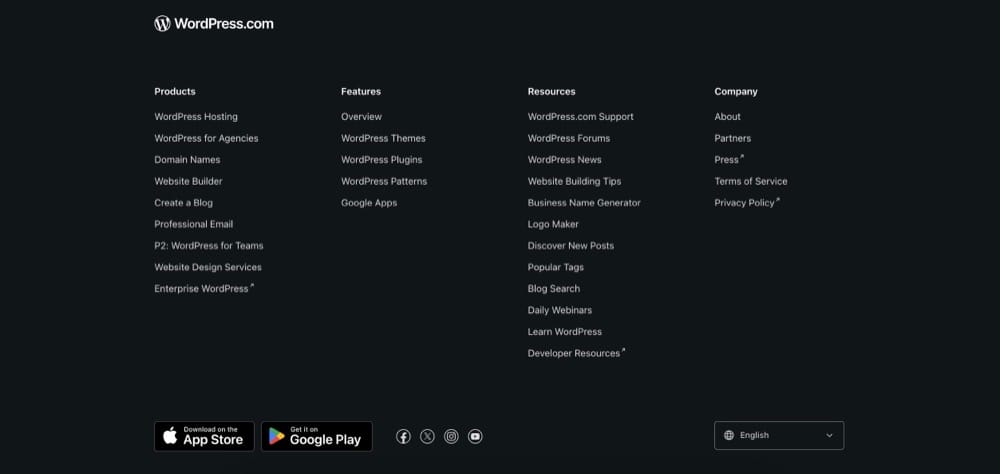The footer is an often underrated part of your website. In this article we’ll help you identify how to edit your site footer, whether you’re using a newer block theme or a classic WordPress theme.

How to edit the Footer in WordPress?
It does not need to be a skilled web developer to edit the WordPress site. The method you’ll use depends on your WordPress theme type.
Method 1: Using the site editor (for block themes that support Full Site Editing)
If your theme supports full-site editing:
- Log in to your WordPress dashboard
- Navigate to Appearance → Editor
- Scroll to the bottom of the page
- Click within the footer area to begin editing
Steps for customising in the Site Editor:
- Add new blocks: Click the “+” icon to insert text, images, buttons, etc.
- Modify existing blocks: Click on a block to reveal its settings in the sidebar
- Rearrange elements: Click and drag blocks to reposition them
- Use pre-designed patterns: Click the “+” icon, select “Patterns,” and search for “Footer” to use pre-designed layouts
🌊 Too busy to manage your WordPress site? Our expert team handles all your website needs – from fixes to improvements – while you focus on running your business. Start with our WordPress retainer service →
Method 2: Using widgets (for classic themes)
For themes that don’t support full-site editing:
- Go to Appearance → Widgets in your dashboard
- Locate the “Footer” widget area (name may vary by theme)
- Click to expand the footer section
- Add, remove, or modify widgets as needed
Steps for managing widgets:
- Add widgets: Drag and drop widgets from the available list to the footer area
- Remove widgets: Click the widget’s down arrow and select “Delete”
- Rearrange widgets: Drag widgets to new positions within the footer
How to edit specific footer elements
There are specific parts of your website footer that can be edited quickly and easily.
1. Adding/Editing copyright information
- In the Site Editor: Use a Paragraph block and enter your copyright text
- In Widgets: Use a Text or Custom HTML widget
Example text:
| (c) 2024 Your Company Name. All Rights Reserved. |
2. Inserting contact information
Use a Paragraph block or Custom HTML widget:
| <p>Email: contact@yourwebsite.com</p> <p>Phone: (123) 456-7890</p> <p>Address: 123 Main St, Anytown, USA</p> |
3. Adding social media links
- In the Site Editor: Use the Social Icons block
- In Widgets: Use a plugin like “Social Media Icons Widget” or your theme’s built-in social media widget
Extra footer customisation
Our clients sometimes ask how they can set different footers for specific pages and customise the appearance of their footers.
Creating different footers for different pages
In the Site Editor:
- Click the WordPress logo in the top left
- Select “Template Parts”
- Click “Add New” and choose “Footer”
- Design your custom footer
- Assign it to specific pages or post types in the settings sidebar
Customising footer appearance
- In the Site Editor: Use the styles panel to adjust colors, typography, and layout
- In classic themes: Use the Customizer (Appearance → Customize) or your theme’s options panel
What’s in a footer?
It usually contains key information that’s useful for your visitors and helps with navigation. You can think of it as a quick reference for important details.
Some common references that websites usually include in their footers:
- Copyright info – Shows the ownership of the content.
- Contact details – Easy access to your email or phone number.
- Navigation links – Shortcuts to important pages, like About or Contact.
- Social media buttons – Links to your social profiles.
- Legal disclaimers – Privacy policies or terms of use.
- Newsletter sign-up forms – A way for visitors to subscribe to updates.
FAQ
1. How do I access the footer credit options on WordPress.com?
Go to your WordPress.com dashboard, navigate to My Site → Customize → Footer, and find the “Footer Credit” section.
2. What are the best practices for designing a website footer?
- Keep the design simple and uncluttered.
- Ensure readability with good contrast between text and background.
- Make links easy to click
- Maintain consistency with your overall site design.
Conclusion
Tweaking your WordPress footer can make a big difference in how your site works and feels for users. Whether you’re using a block theme or a classic one, these tips will help you build a footer that works well for both your visitors and your site’s goals.
Don’t forget to check and update your footer from time to time to make sure it still fits your site’s changing needs and adds value for visitors. Done right, your footer can be a handy tool for navigation, sharing info, and keeping people engaged on your WordPress site.





